-
Before Christmas to New Year's period, it's quite high temperature, then it suddenly gets cold Lots of rain on the Pacific side, same or less snowfall on the Sea of ??Japan side
2025/12/18 15:47
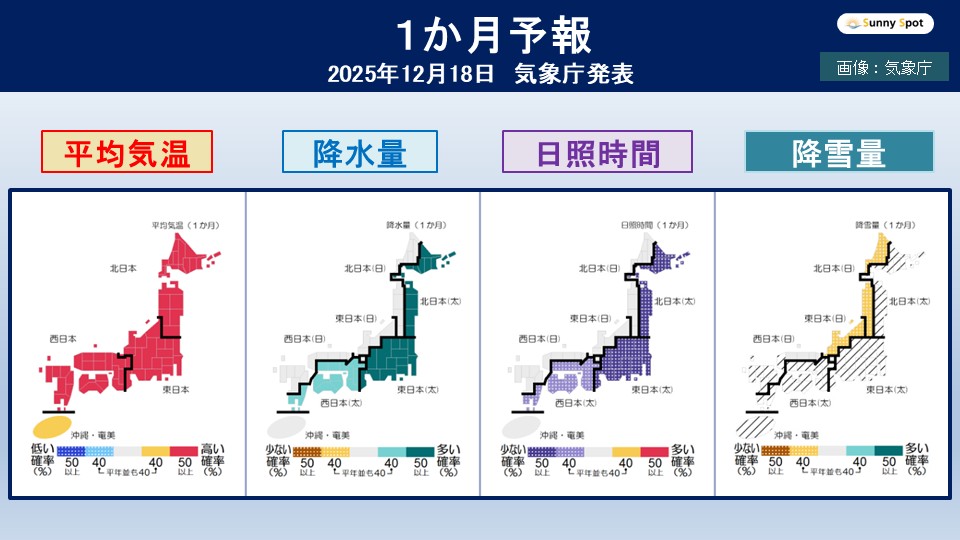
-
Today, the 18th (Thursday), the Japan Meteorological Agency announced the weather outlook for the next month (12/20 to 1/19).
The winter-like atmospheric pressure pattern will not last long, and temperatures are expected to rise considerably in northern and western Japan from before Christmas until the end of the year.
Also, the Pacific side of northern and eastern Japan, which is susceptible to the effects of low pressure, will experience higher than normal precipitation.
#Winter-type pressure pattern won't last long
Looking ahead, the average sea level pressure for the month is predicted to be that the Aleutian Low pressure system will be weaker than normal, and the Siberian High pressure system will also be weaker in the area near Japan, so the winter-type pressure pattern near Japan will not last long.
It is expected that there will be periods when the Pacific side of northern and eastern Japan is susceptible to the effects of low pressure.
Temperatures at an altitude of approximately 1,500 meters are predicted to be higher than normal, mainly in northern, eastern, and western Japan.
#Significantly high temperature before Christmas to New Year's period Snowfall will be average/low/not affected by cold air, so temperatures over the next month will be high in northern, eastern, and western Japan, and at or above normal in Okinawa and Amami.
In particular, temperatures are expected to rise considerably in northern, eastern, and western Japan from December 20th to January 2nd of next year, before Christmas and into the New Year period.
However, during events and events where you spend a long time outdoors, such as Christmas, illuminations, New Year's Eve, and New Year's visit, please be careful and take measures to protect yourself from the cold.
After January 3, the temperature will be similar to normal, and it will feel like it has suddenly become colder, so please take care of your health.
Also, the amount of snowfall over the next month will be at or below normal on the Sea of Japan side of northern and eastern Japan.
In areas where there is a lot of snow, be careful of damage from melting snow.
#Pacific side of northern and eastern Japan, susceptible to the effects of low pressure There will be periods of high precipitation
that are susceptible to low pressure, so precipitation over the next month will be heavy on the Pacific side of northern and eastern Japan, and at or above normal on the Pacific side of western Japan.
The amount of sunshine in the coming month will be low on the Pacific side of northern and eastern Japan, and will be at or below normal on the Pacific side of western Japan.
This time of year, the Pacific side tends to be dry, but this year the air will be moist due to the heavy rain.
The weather is expected to change in a short period of time on the Pacific side as well, so please check the weekly weather forecast and plan accordingly when preparing for the year-end and New Year holidays, such as cleaning.
-
It rains on Saturday and Sunday, and it rains widely on Christmas.Where will it be a white Christmas [Weekly weather]
2025/12/18 11:52

-
By tomorrow, the 19th (Friday), the area around Honshu will be covered in high pressure, and it will be sunny in many places, including the Sea of Japan side.
However, there will be widespread rain on Saturday and Sunday, and it is expected to rain in many places during the Christmas period from
24th (Wednesday) to 25th (Thursday).
Will there be a "white Christmas" this year
On the 20th (Saturday), the center of the high pressure system will move to the east,
humid air will more easily flow into Japan from the south, and
it is expected to start raining in places such as Hokkaido, Kyushu, and the Tokai region.
Furthermore, on the night of the 20th (Saturday), a low pressure system accompanied by a front will advance over the Sea of Japan, and
will likely be due to the low pressure system and front passing through Honshu by the 21st (Sunday).
For this reason, it is likely to rain across the country.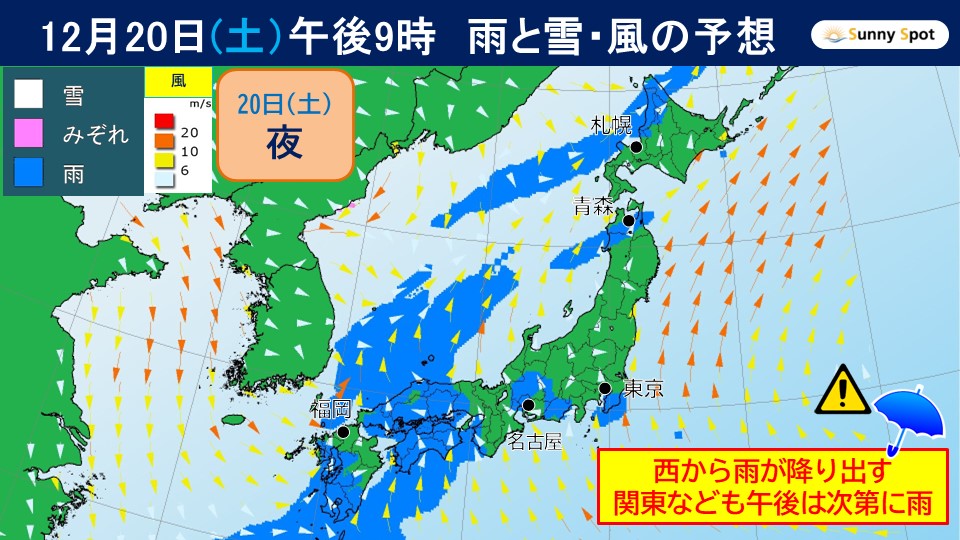
Looking at the rain, snow, and wind forecast for the night of the 20th (Saturday),
Western Japan is expected to experience widespread rain, and there will likely be some places in the Tokai and Kanto regions as well.
Furthermore, there are many places around Hokkaido where it starts to rain.
Before noon on the 21st (Sunday), it is likely to rain widely across the Kinki and Tohoku regions.
On the Pacific side of western and eastern Japan, where active rain clouds are flowing,
there is a possibility of heavy rain accompanied by thunder.
Meanwhile, coastal areas of Hokkaido are expected to experience rain and sleet, while inland areas are expected to experience snow.
The temperature will be high and there will be sticky snow with a lot of moisture in many places.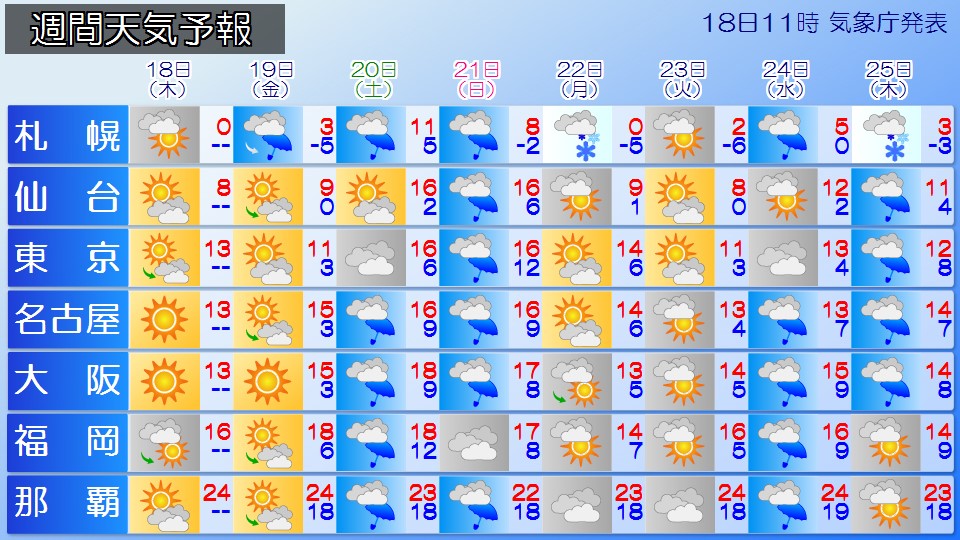
On the 22nd (Monday), the pressure will temporarily be high in the west and low in the east,
cold air will flow in and temperatures will drop.
However, as a strong influx of cold air is not expected,
temperatures are likely to be higher than normal even around Christmas.
On the 23rd (Tuesday), a high pressure system will come in from the north, so
it will likely be sunny in many places, including the Sea of Japan.
Sapporo will also experience positive temperatures.
On Christmas Eve, the 24th (Wednesday), rain is expected to begin in many places from the west as the next low pressure system and front approaches.
It is expected to rain again over a wide area through the 25th (Thursday) of Christmas.
Christmas will bring heavy rain again in some places on the Pacific side of western and eastern Japan, so
If you are planning to go out for Christmas, please be sure to prepare for the rain.
White Christmas refers to a situation in which it snows on Christmas Day and
the ground is covered with snow.
This year (2025), it will snow on Christmas, and the areas where snow will accumulate will be limited to areas north of Sapporo in Hokkaido, such as the Soya, Kamikawa, and Sorachi regions of Hokkaido.
-
Although the weather will be bad in many places on the weekend, the temperature is rising!
2025/12/18 09:47

-
There is a low pressure system in the Sea of Okhotsk that is moving northeast.
Also, there is a low pressure system with a front over the eastern seaboard of the Kanto region, and it is moving northeast.
On the other hand, there are high-pressure systems in Northeast China and the Yellow Sea, each moving southeast.
Currently, there are many clouds near Japan on the Sea of Japan side, and snow and rain are falling in places from Hokkaido to Hokuriku.
Today, high pressure is gradually spreading from the west.
For this reason, snow and rain from Hokkaido to Hokuriku will gradually become narrower.
From Kanto to Kyushu, there are many clouds on the Sea of Japan side, but it will gradually clear up in many places, and there will be many places on the Pacific side that will be sunny.
Okinawa will also be sunny, but it will likely be cloudy and rainy in the Sakishima Islands.
The maximum daytime temperature will be mid-winter in Hokkaido, but in many other areas it will be at or above normal.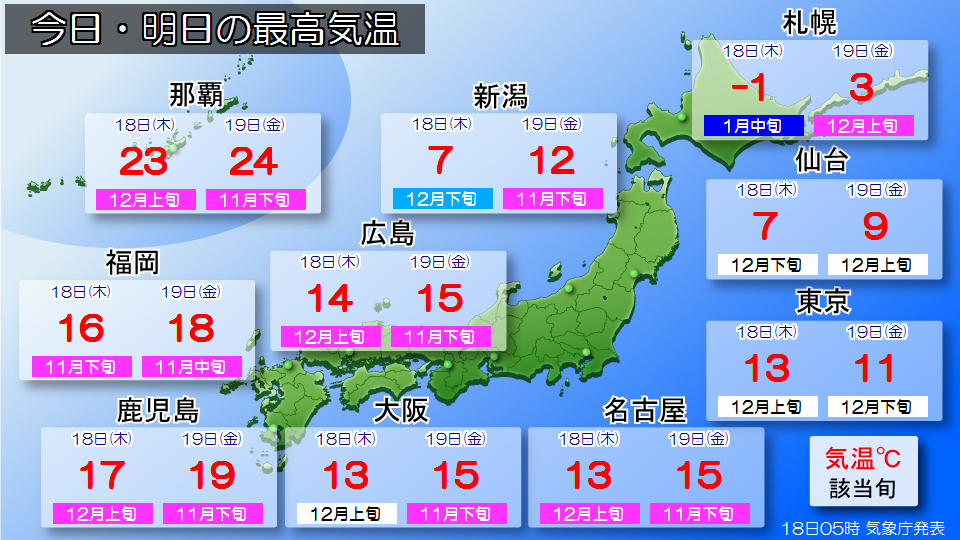
Tomorrow, the 19th (Friday), Hokkaido and the area around Sakishima Shojima Island will be on the edge of a high-pressure system, but the area around Honshu will be covered by a mobile high-pressure system.
For this reason, although there are some places in Hokkaido and the Sakishima Islands, the weather will be sunny, especially in eastern and western Japan to the main island of Okinawa.
The temperature during the day is also higher than normal in many places, making it a pleasant and sunny day for this time of year.
On the weekend, from the 20th (Saturday) to the 21st (Sunday), a pressure trough, a low pressure system, and a front will pass near Japan.
For this reason, it is expected that there will be many places where the weather will be bad.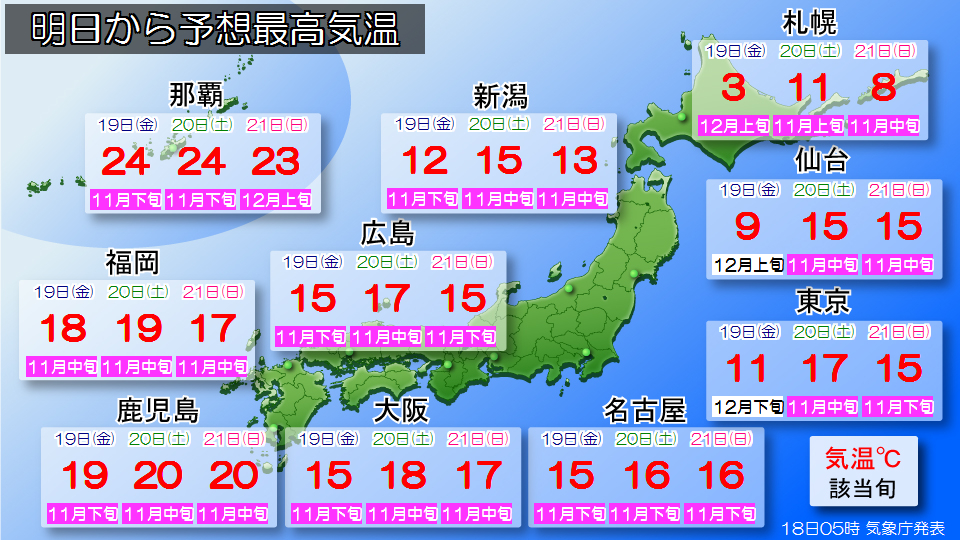
However, as warm air enters from the south, the temperature will rise.
It will be sunny in many places around mid-November.
-
Temperatures will rise and it will rain widely this weekend, with heavy rain in areas such as the Kanto region. Temperatures will plummet at the beginning of the week [Weekly Weather]
2025/12/17 16:12

-
Rain is expected to fall over a wide area this weekend due to the influence of low pressure and warm air flowing toward the front.
There is a risk of heavy rain on the Pacific side of western and eastern Japan.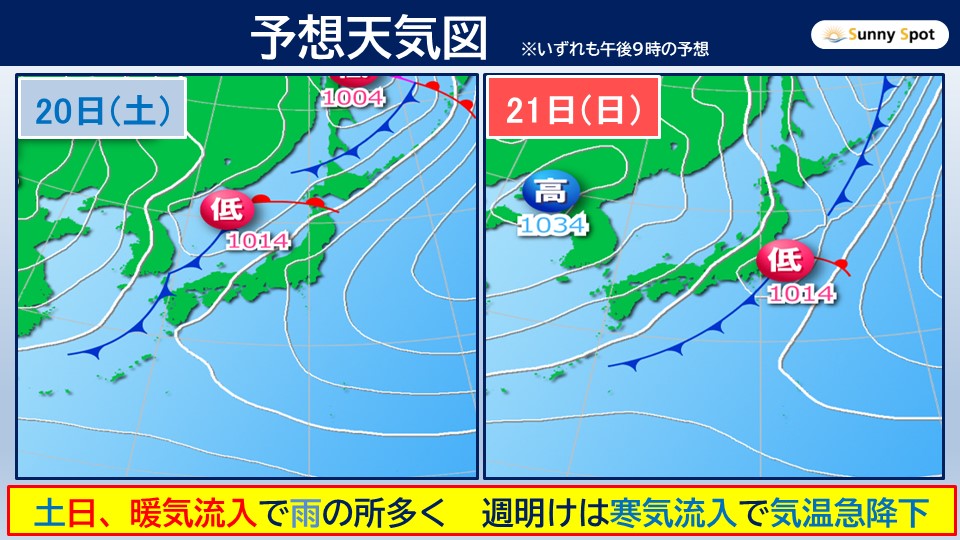
Looking at the forecast weather map for Saturday and Sunday, a low pressure system with a front is expected to move into the Sea of Japan on the 20th (Saturday).
On the 21st (Sunday), another low pressure system will form near the Kanto region,
and is expected to develop slightly as it moves east of the Kanto region.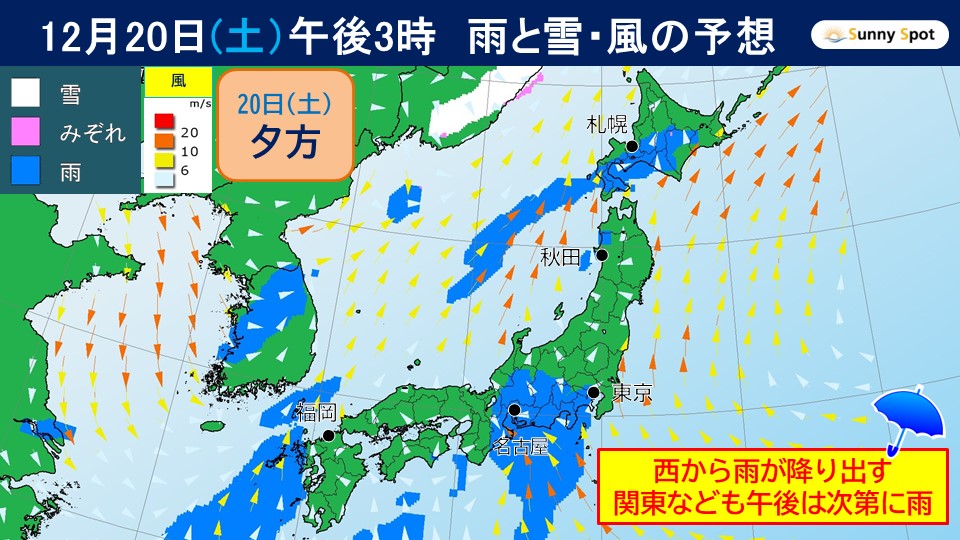
Warm air will flow in towards the low pressure system and front,
and there will be rain in many places from Kyushu to Hokkaido.
There are places in Hokkaido where it rains, so
you need to be careful about deteriorating road conditions due to melting snow, snow falling from roofs,
avalanches along the mountains, etc.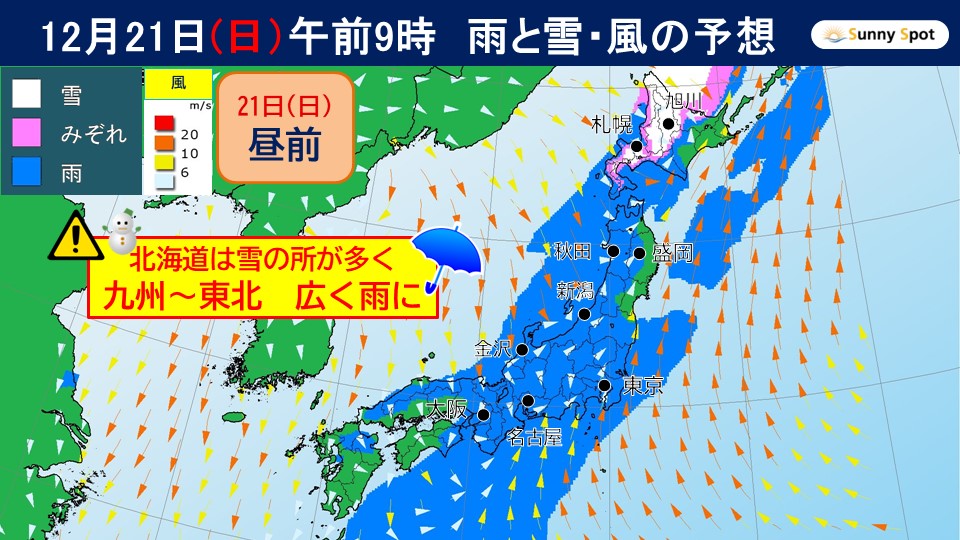
On the 21st (Sunday), another low pressure system is expected to form near the Kanto region and
is expected to develop slightly and move east of the Kanto region.
On the 21st (Sunday), there will be snow in some places in northern Hokkaido, but there will be rain in many places in southern Hokkaido.
Continue to pay close attention to changes in road conditions.
Also, please be aware that there is a risk of strong rain and winds on the Pacific side of eastern Japan, such as the Kanto region, which is close to the center of the low pressure system.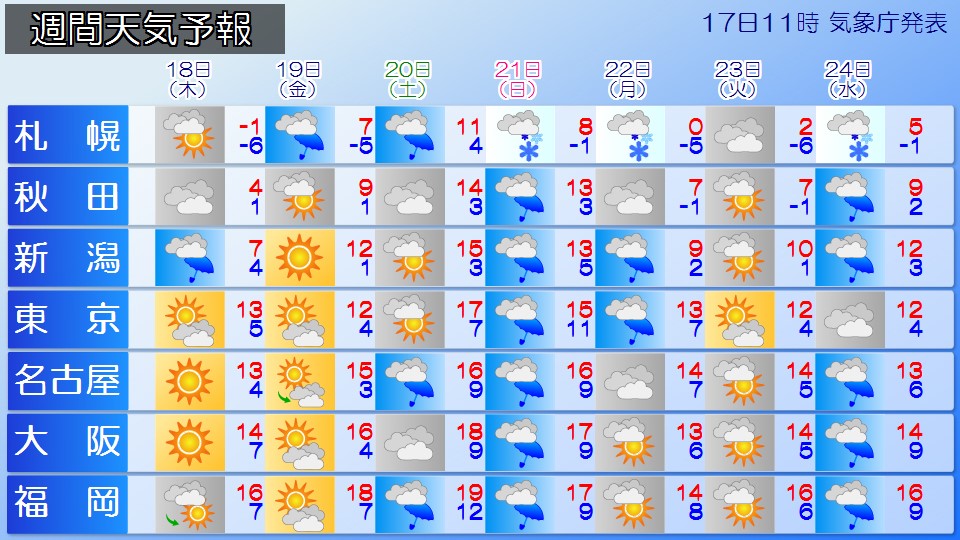
On the 22nd (Monday), cold air will flow in around Japan, with a winter-like pressure pattern of high in the west and low in the east.
As a result, the temperature is expected to drop again next week, and the cold weather of December is expected to return.
Please be careful not to get sick due to the temperature difference.
-
[Marine Summary] Rapid development of cyclone, blizzard in northern Japan, heavy rockfall in the Sea of ??Okhotsk (December 7, 2025 - December 13, 2025)
2025/12/17 15:43

-
Near Japan, the atmospheric pressure distribution was temporarily high in the west and low in the east, and the pressure distribution became winter-like, with the gradient of atmospheric pressure increasing frequently.
A low-pressure system rapidly developed as it moved through the waters near the Chishima Islands, causing stormy winds to rage over northern Japan and causing major turbulence in the Sea of Okhotsk.
Below, ocean summary from December 7th to December 13th, 2025.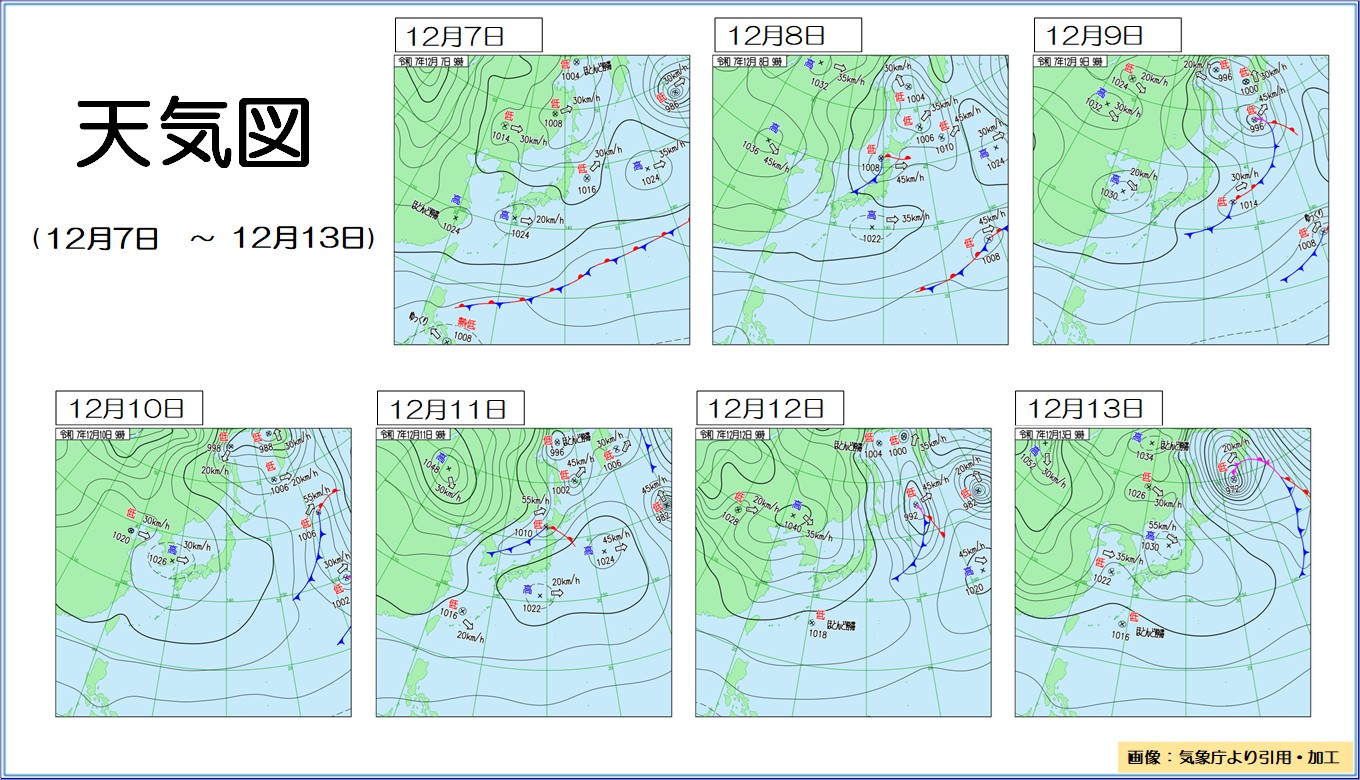
#Pressure distribution and waves
On the 7th, a continental low pressure system moved eastward, and on the 8th, another low pressure system accompanied by a front moved eastward from the Sea of Japan to northern Japan.
Also, from the 7th to the 8th, a high pressure system moved south of Japan, and the pressure gradient became larger in the Sea of Japan between the low and high pressure systems.
In the Sea of Japan, waves rose mainly in the central region.
On the 9th, a low pressure system accompanied by a front moved eastward east of Japan, and an anticyclone moved over the Yellow Sea, resulting in a high pressure system in the west and low pressure in the east.
The gradient of atmospheric pressure became larger near Japan, and waves became higher in the central and northern parts of the Japan Sea, as well as in the east of Japan.
On the 12th and 13th, a low pressure system accompanied by a front rapidly developed and moved near the Kuril Islands, and the continental high pressure system moved toward the Sea of Japan.
The area around Japan has a winter-like atmospheric pressure distribution, and the spacing between isobar lines has become narrower. On the 12th, there was a barge in the Sea of Japan and the east of Japan, and on the 13th, there was a barge in the east of Japan, followed by a large barge in the Sea of Okhotsk.
#Sea surface temperature
Sea surface temperatures in the Japanese waters continued to be lower than normal along the coast of Hokkaido.
The central and western regions continued to experience sea levels that were either higher than normal or significantly higher than normal.
The East China Sea continued to be at normal levels, and the west of Kyushu was slightly above normal.
Sea areas south of Japan continued to be at normal levels, but waters off the Tokai Sea continued to be below normal levels.
To the east of Japan, temperatures continued to be significantly higher than normal, with temperatures up to 4 C higher.
On the other hand, off the coast of Sanriku, areas slightly lower than normal have expanded.
The sea off the southeast coast of Hokkaido was lower than normal, and the Sea of Okhotsk remained near normal.
-
The weather will deteriorate widely. There will be showers tonight in the Kanto region. Atmospheric conditions are very unstable. On the Sea of ??Japan side, be careful of thunderstorms, tornadoes, and other strong gusts.
2025/12/17 12:11

-
Today, the 17th (Wednesday), a low-pressure system is moving eastward across the Sea of Japan, causing rain in parts of northern Kyushu, the San'in region, and Hokuriku.
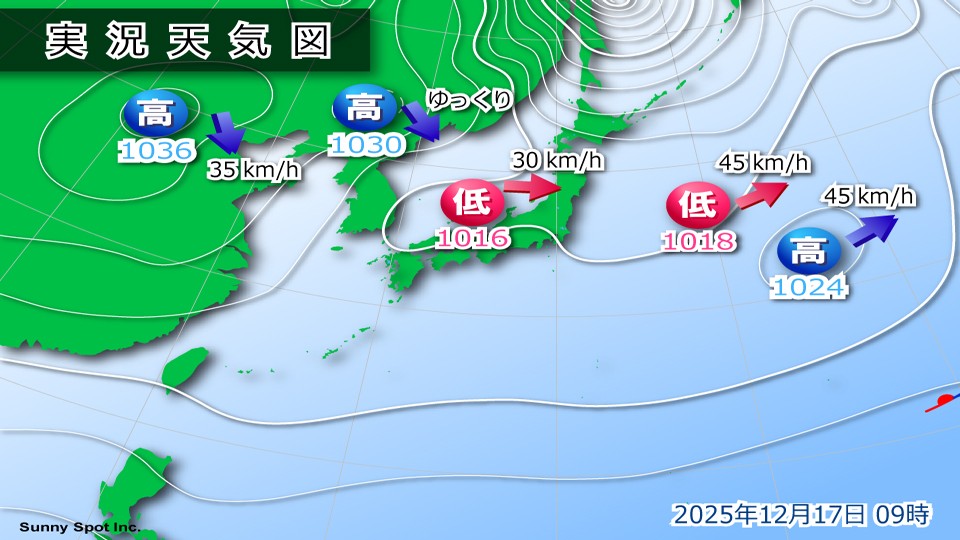
This low pressure system will move towards the coast of Honshu on the Sea of Japan side today, Wednesday, the 17th.
Also, a new low pressure system with a front has formed to the east of Japan and is expected to move eastward.
In the afternoon, it will gradually start to rain in western Japan, even on the Pacific side, and it will be widespread.
Clouds are expected to gradually increase in the sunny Tokai and Koshin areas.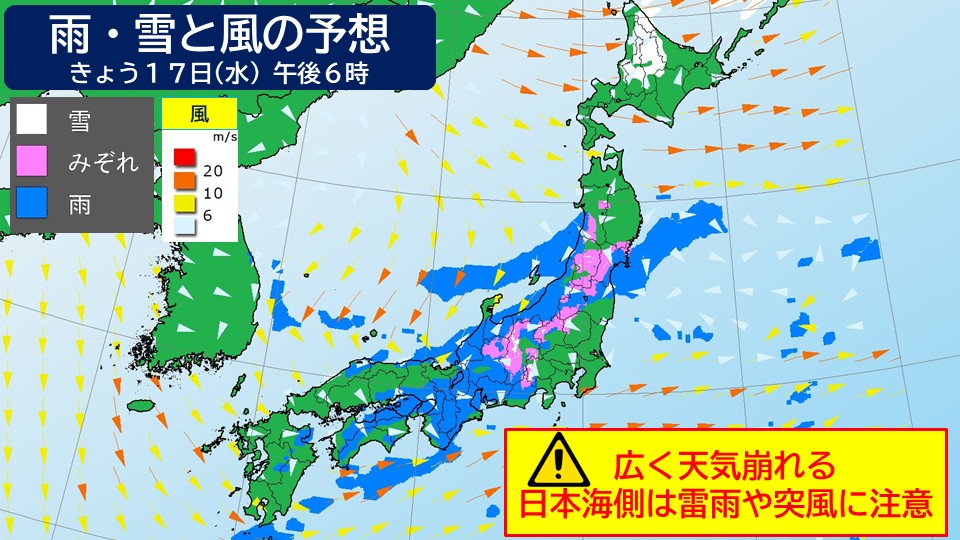
After the evening, there will be places where it will start to rain, and there will be places where it will snow along the mountains.
In the Kanto region, clouds are expected to increase along the coast.
There will be rain along the Hokuriku coast, and snow in places along the Hokuriku mountains, Tohoku, and northern Hokkaido.
At night, the area of rain in western Japan and the Tokai region will gradually become narrower.
Meanwhile, showers are expected in Chiba and Ibaraki prefectures.
There are probably places in Tohoku where it snows, even on the Pacific side.
Atmospheric conditions are expected to become extremely unstable, mainly from northern Kyushu to Hokuriku on the Sea of Japan side, due to the effects of warm, humid air heading towards the low pressure front and cold air above.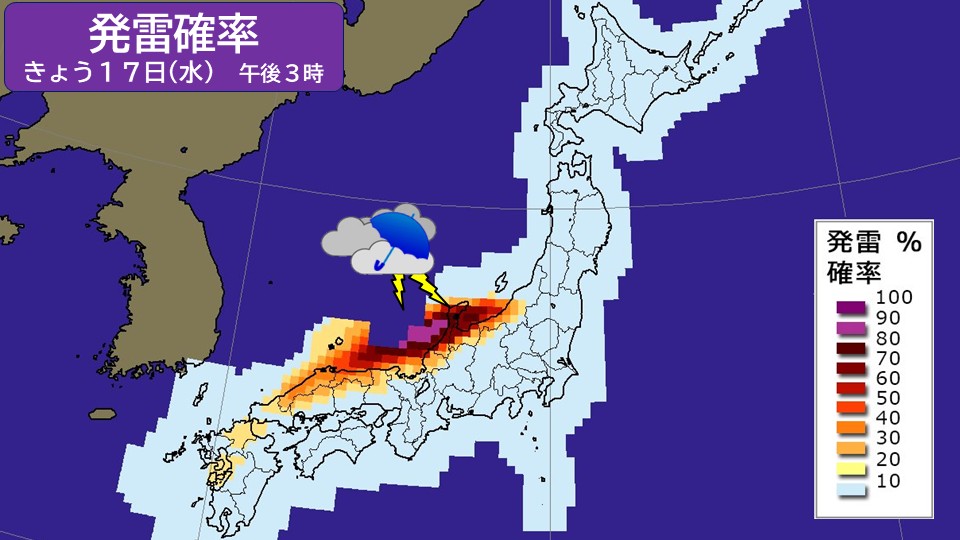
Cumulonimbus clouds may develop locally, leading to strong gusts of wind such as lightning and tornadoes.
Be careful of thunderstorms, tornadoes, strong gusts of wind, and sudden heavy rain.
-
Weekly weather Unseasonably warm due to periodic weather changes Be careful of avalanches in areas with heavy snowfall
2025/12/17 08:43

-
The weather for the coming week will be periodic, with high and low pressure systems passing over Honshu alternately. Especially from around the 20th, it looks like some places will experience unseasonably warm weather.
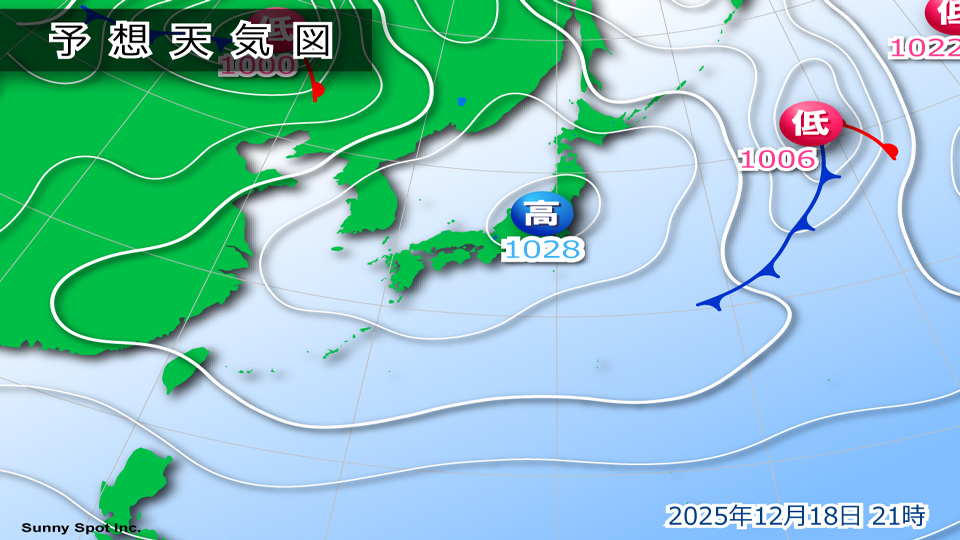
Tomorrow, the 18th (Thursday), the area around Honshu will be widely covered by high pressure. There are a lot of clouds on the Sea of Japan side, and there may be some snow or rain in the morning, but it is expected to stop around noon. The Pacific side of northern Japan and the Pacific side of eastern and western Japan will be largely sunny.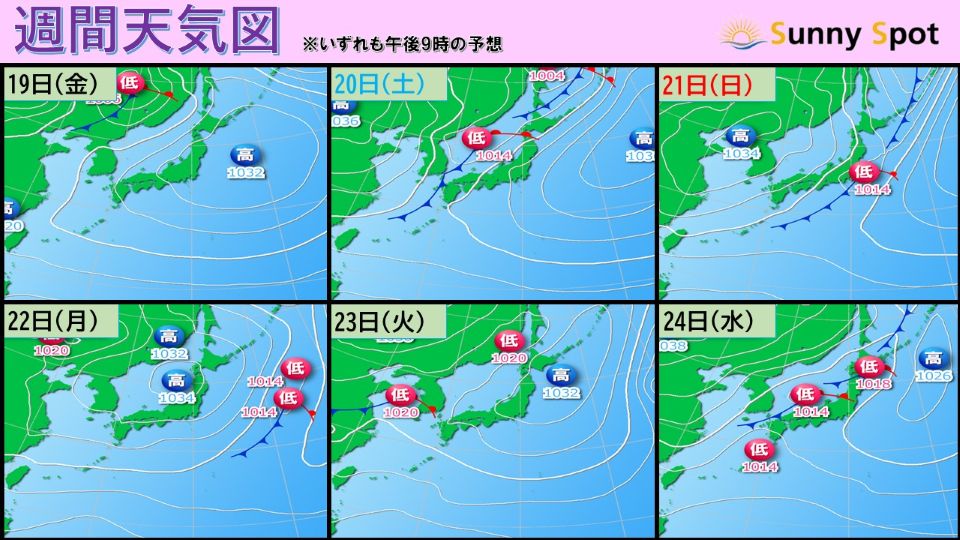
After that, the high pressure system moves away to the east of Japan, and the low pressure system and front gradually approach. The next day, the 19th (Friday), rain is forecast in northern Japan, mainly on the Sea of Japan side of Hokkaido. From Saturday the 20th to around the 22nd, there will be a trough of atmospheric pressure around Honshu, and a low pressure system and front will pass through. As a result, it will rain across the country, and in some places the rain will become heavier. Warm air from the south toward the low pressure system will easily enter, and the cold will ease in many places, making it much warmer than normal.
In areas with heavy snowfall, rising temperatures and rain will cause the snow to melt further, making avalanches and falling snow more likely. Please be very careful.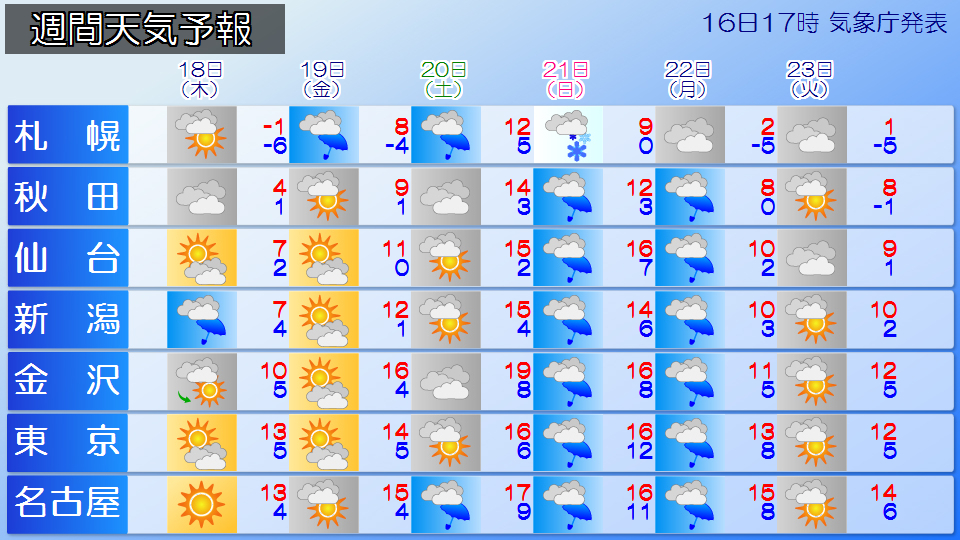
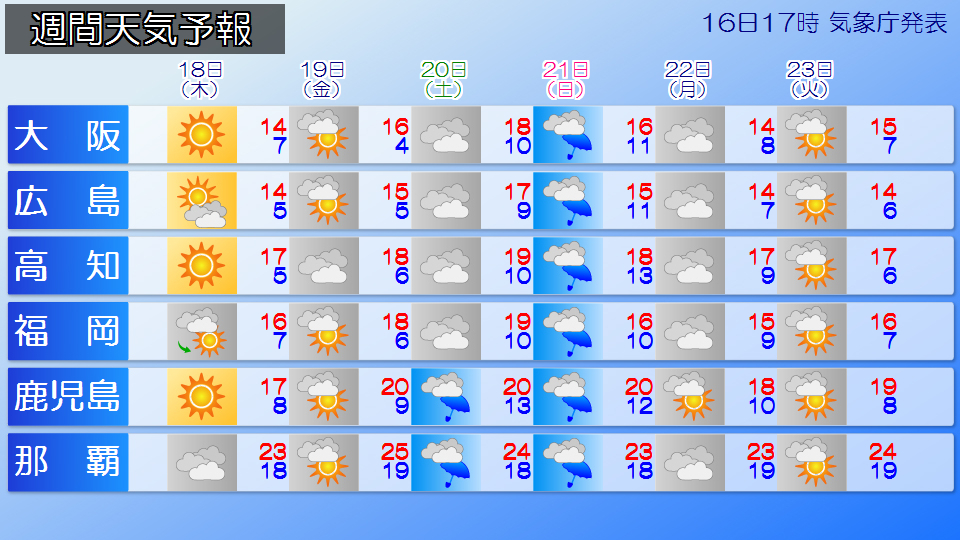
-
Today, the 17th (Wednesday), widespread rain and thunderstorms are expected from Tohoku to Kyushu on the Sea of Japan side. Beware of blizzard on the Sea of Japan side of Hokkaido.
2025/12/17 07:39

-
Today, the 17th (Wednesday), a low pressure system will move eastward over the Sea of Japan, causing unstable atmospheric conditions mainly on the Sea of Japan side. In the afternoon, the weather is likely to turn downhill on the Pacific side of western Japan as well.
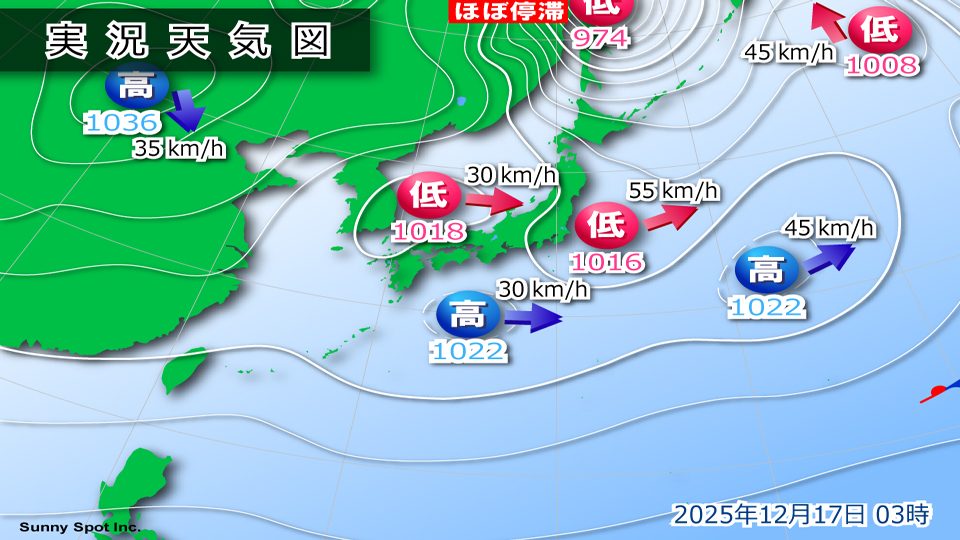
In Hokkaido, due to the influence of the low pressure stationary near Sakhalin, the intervals between isobars are narrow, and the westerly wind blows strongly. On the Sea of Japan side, it is expected that there will be intermittent snowstorms in places, so please be careful of poor visibility due to the snowstorms.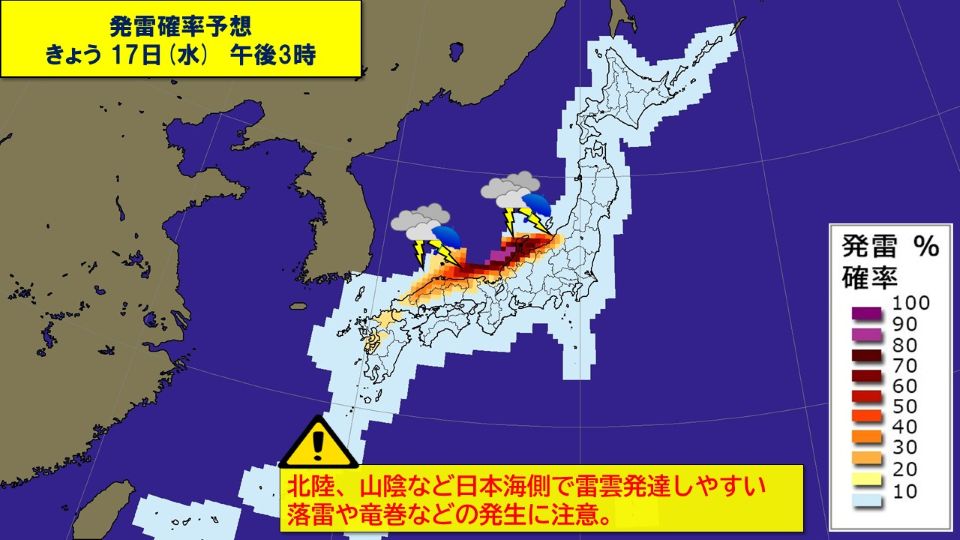
On the Japan Sea side from Tohoku to northern Kyushu, the weather will be downhill due to the influence of low pressure.
It will start raining in the morning in Hokuriku, San'in, and northern Kyushu. From Hokuriku to the San'in region, thunderclouds are expected to develop especially in the afternoon, so please be careful of thunderstorms, tornadoes, strong gusts of wind, sleet, and hail.
In the afternoon, it is expected to gradually rain and snow in the Tohoku region, and it is expected to gradually start to rain in some places on the Pacific side of western Japan, such as Shikoku and the Kii Peninsula, as well as in the Tokai region.
The sky is becoming increasingly cloudy in the Kanto region, and there is a possibility of showers in coastal areas tonight.
In Hokkaido, the predicted maximum daytime temperature in places such as Sapporo and Asahikawa will not reach 0c, making it a midwinter day, and it will be bitterly cold. Be sure to take all possible measures to protect yourself from the cold.
From Tohoku to Kyushu and Okinawa, there will be many places where the weather will be at or above normal. However, the clouds spread, making it difficult for sunlight to reach, and there are periods when it rains, so it can feel cold.
-
Weather is expected to deteriorate widely tomorrow; atmospheric conditions are extremely unstable. Be careful of thunderstorms, tornadoes, and other strong gusts.
2025/12/16 16:47

-
A low pressure system will form in the western part of the Sea of Japan on the night of today, the 16th (Tuesday), and will move east-southeast into tomorrow, the 17th (Wednesday).
Also, a front is expected to extend to the south of Japan on the night of tomorrow, Wednesday the 17th.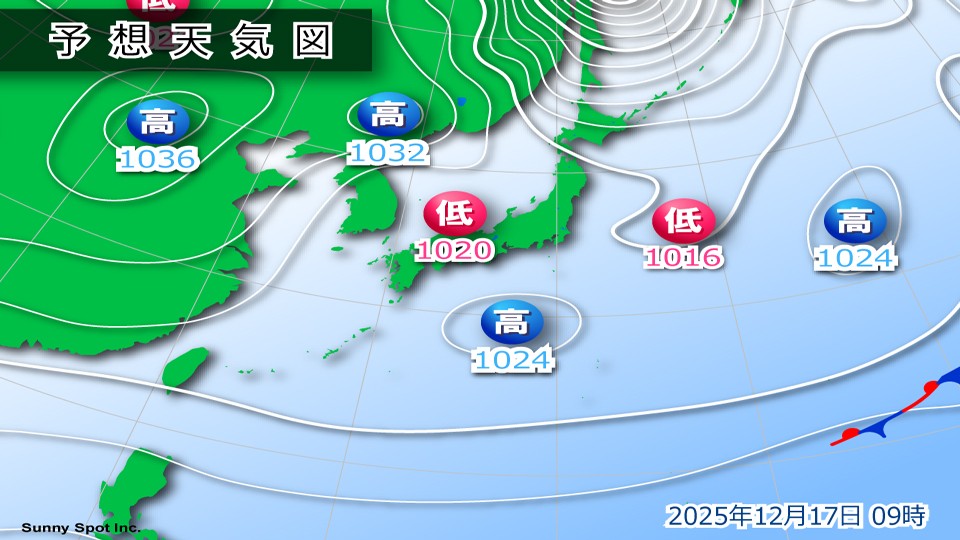
Tomorrow, the 17th (Wednesday), there will be some places where it will rain in the morning along the coasts of northern Kyushu, San'in, and Hokuriku, and there will be places where it will snow along the mountains of Hokuriku, Tohoku, and northern Hokkaido.
The area where the rain will fall will spread from the Sea of Japan side, and in the afternoon it is expected to rain widely in western Japan, including the Pacific side.
After the evening, there will be places in Tokai and Koshin where it will start to rain, and there will be places along the mountains where it will snow.
At night, the area where it will rain in western Japan and the Tokai region will gradually narrow down, and it is expected that there will be places in Tohoku where it will snow even on the Pacific side.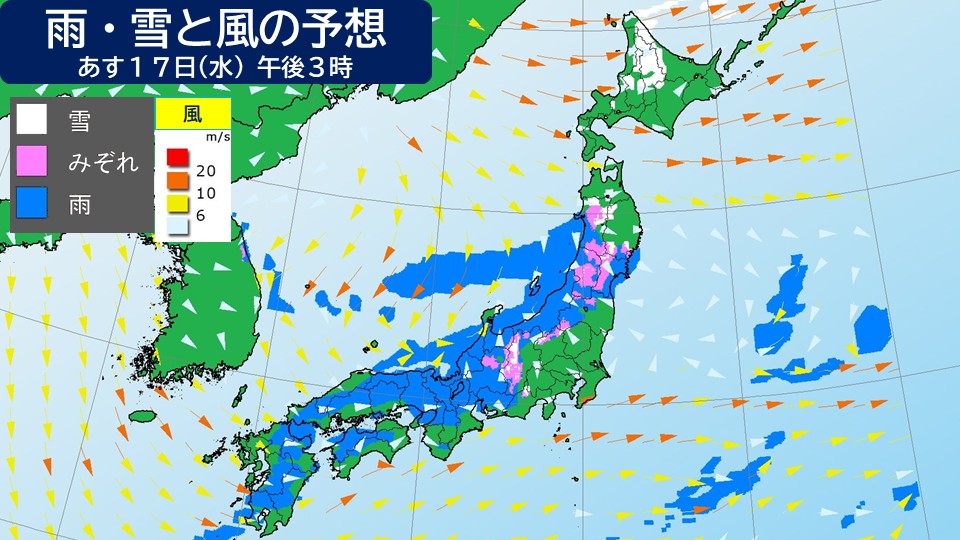
Atmospheric conditions will be extremely unstable mainly from northern Kyushu to Hokuriku on the Sea of Japan side due to the effects of warm, humid air heading towards the low pressure front and cold air above.
Cumulonimbus clouds may develop locally, leading to strong gusts of wind such as lightning and tornadoes.
Be careful of thunderstorms, tornadoes, strong gusts of wind, and sudden heavy rain.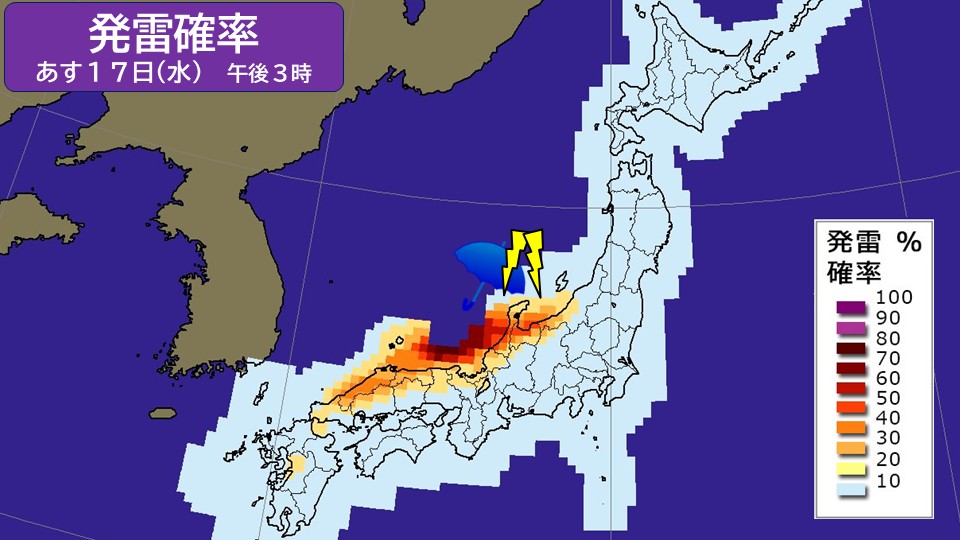
-
This year's Christmas will be "quite high"; there will be few areas with a white Christmas [Christmas 10-day forecast]
2025/12/16 12:34

-
It's finally almost a week until Christmas.
It has been predicted for some time that there will be a ``high temperature trend'' nationwide this Christmas, but will there be a white Christmas
We have also started to see some more detailed weather trends, so we would like to share them with you.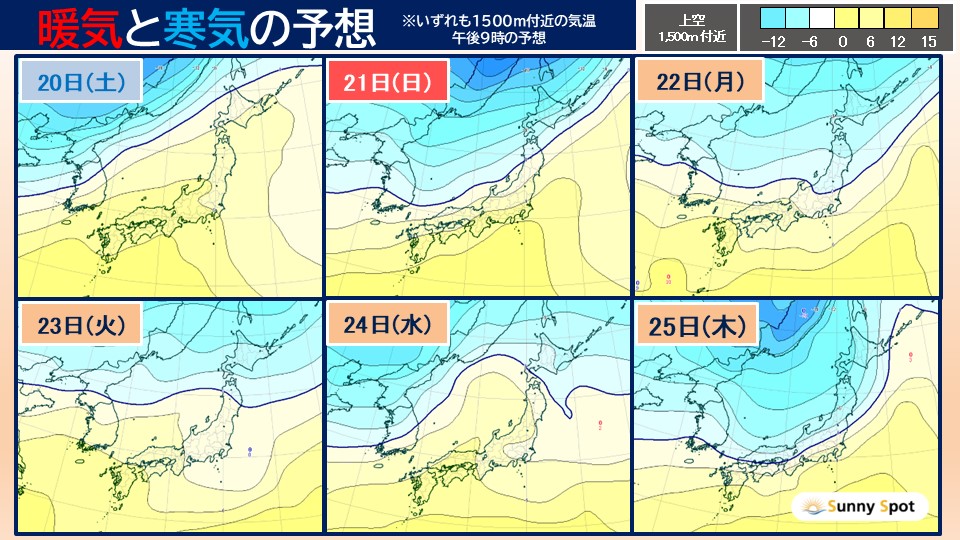
#Christmas will be warm with lots of rain instead of snow#
Looking at the forecast for cold and warm air from the 20th (Saturday), the
dark blue line is a guideline for cold air that will bring snow in the mountains.
From the weekend until Christmas next week, the dark blue line will move north, and
the warm air in the yellow area will more easily flow in.
For this reason, the weather is likely to be covered with warm air, and
there are few expected to be extremely cold days.
Especially around Christmas Eve, the 24th (Wednesday), warm air will flow towards the
low pressure system passing near Hokkaido.
Whatever falls in the Tohoku region is likely to turn into rain,
On the night of the 25th of Christmas,
winter-like atmospheric pressure patterns are expected to strengthen, and cold air is expected to flow in.
It seems that some ski resorts are scheduled to open before Christmas, but
there are few snowy days around Christmas, which is a troubling forecast for
ski resorts.
Even in flat areas, there are not as many snowy days in the lead up to Christmas as in previous years, and there will be few places that will have a "white Christmas" this year.
*White Christmas...The state where the ground is covered with snow on Christmas day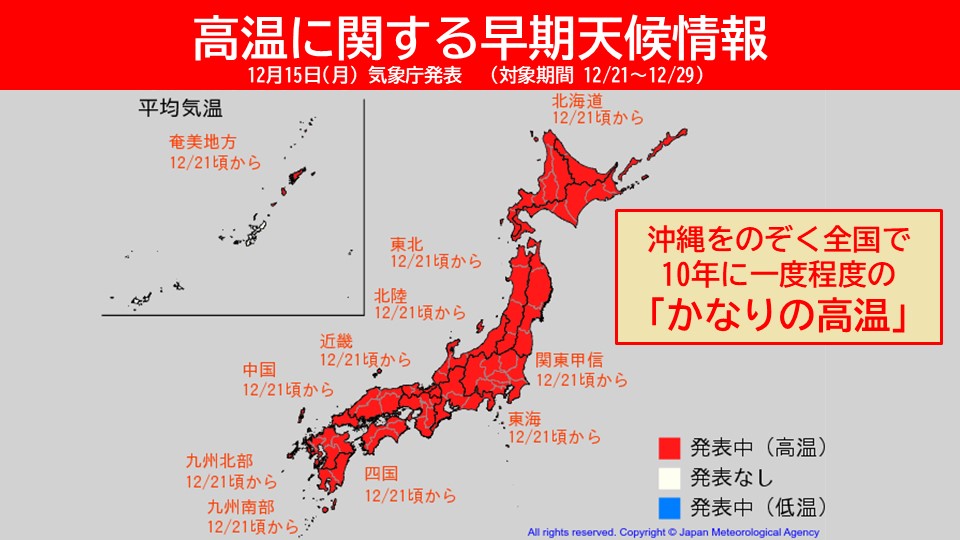
#At this time of year, there is a once-in-a-decade "high temperature trend"#
According to the
"Early weather information regarding high temperatures" released by the Japan Meteorological Agency on Monday, the 15th yesterday,
it is predicted that temperatures will be higher than normal from around December 21st across the country, excluding Okinawa, and that
there is a possibility of "considerably high temperatures."
At this time of year, it seems that some places will experience high temperatures that only occur once every 10 years.
You also need to be careful about managing your crops.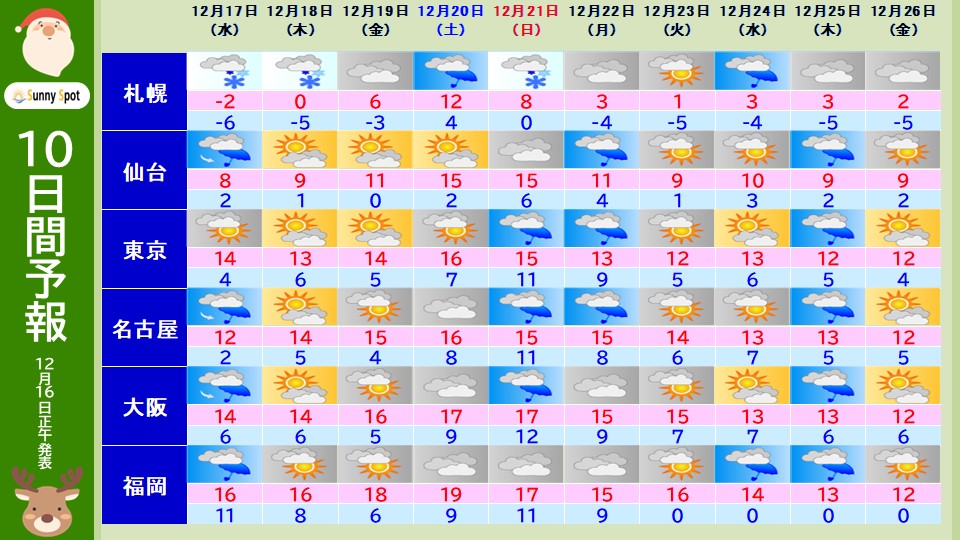
Finally, let's take a look at the latest 10-day forecast for major cities leading up to Christmas.
The weather will be covered by high pressure until the 19th (Friday), and it will be sunny in many places, but on the 20th (Saturday), the weather will be downhill from the west, and on the 21st (Sunday), a front will pass near Honshu, causing widespread rain.
There will be some lingering rain on the 22nd (Monday) at first, but
the weather will gradually improve.
From Christmas Eve 24th (Wednesday) to Christmas 25th (Thursday), the
low pressure system will develop and move towards northern Japan, so winds will be strong across the country.
On the 24th (Wednesday), it will start to rain from Hokkaido and Kyushu, and on the 25th (Thursday), it will rain nationwide, and it will likely snow in parts of Hokkaido.
Christmas temperatures are expected to be high, and even if it rains, it won't be freezing cold.







